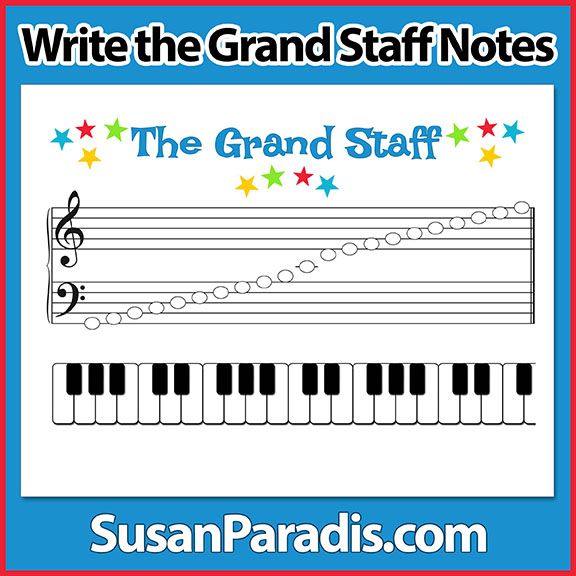Write the Grand Staff from G to F

In this worksheet, students write the name of the note inside each note. You can also have them draw lines to the corresponding piano keys if you have time. It can even be inserted into their binder as a handy guide.
Typically, piano students are taught the notes on the treble staff and the bass staff. But many times students don’t realize the logical continuity of the grand staff. We know the grand staff is more than two separate entities, one for right hand and one for left. However, there is just so much to teach in so little time that it is easy to have short cuts to learning concepts in order to get everything covered. If you have ever had students who need to see the overall picture of the grand staff, this little work sheet might help. It shows clearly how the music alphabet continues from bass to treble staff.
Elizabeth Gutierrez suggests using A C E to learn the grand staff. My students find A C E easier than some other ways. It also helps them to learn the inner ledger lines. So I have students circle all the ACE’s on the grand staff. There is no reason you can’t use guide notes, A C E or FACE, or Every Good Boy Does Fine, or whatever you find successful with a particular student.
Learning note names will not necessarily make students good sight readers. Different parts of the brain are used to identify notes than to actually sight-read notes at the piano. However, learning notes will help our students become overall better musicians. Learning note names can be difficult for some students, but we have to keep trying!
Here is a little tidbit for your students. The phrase GRAND STAFF starts with G and ends with F. How is that for a coincidence!

I never realized about the different areas of the brain being used for sight reading vs. note recognition. That explains a lot!! I love this visual, and especially your tidbit about the word GrandstafF. Very clever! My students enjoy your materials. Thank you for all you do, and your generosity. With my husband being unemployed for 3 years, your work has been a Godsend to supplement my lessons. God bless.
Thank you for your comments. It explains why students can know theory very well and still have problems sight reading. I tell my poor readers not to get discouraged, that sight reading can improve. I’m glad to know that I’m helping you out and that your students like the material. If you don’t already, consider charging students a yearly printing fee. Also, I order off brand ink, and it saves me a lot!
I love this!! I only recently discovered your site and am very grateful!! So full of clever ideas. I printed off the piano solo “Water Lilies” and my young students absolutely love it!! Thank you so much!
Thank you, Rhonda. There is a companion piece called Windsong, also, that has received good reviews.
GF — truly an “elegant” teaching tool!
Thanks very much, Martha.
What a great tit-bit!! Thanks so much-I’m amazed that it had never occured to me! I’m sure it will be useful for students, especially older beginners.
I shall use it a lot, but in the UK we say Grand Stave rather than staff so would there be any chance of a UK version of the PDF ?- especially as I would be drawing their attention to the title!
Kath, thanks for the nice words. I’ll post a UK version on the UK page very soon. If anyone doesn’t know where the UK page it, click on the tab above for “Free” material and follow the link.
Thanks! Great for 1st year students and a wonderful review for 2nd year students to reinforce note names and placement on the Grand Staff.
Brilliant. Simply (and I mean simple!) brilliant! Thanks for the reminder to Keep It Simple, Sweetie. And I never connected G to F (G of Grand to F of Staff) before. Thanks, Susan!